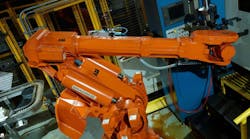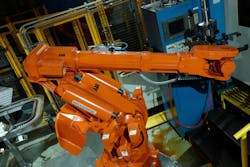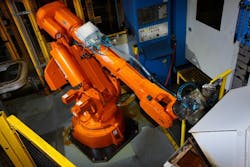That’s one of the thoughts I had after touring Meritor’s 504,000 sq. ft. axle plant in Fletcher, N.C., this week – not in the least due to witnessing the workings of a mammoth 5,000 ton metal press machine.
[To view more pictures of the factory and its inner workings, just click here.]
Called ironically a “Bliss press,” this gargantuan device heats flat metal “blanks” up to 1,400 degrees Fahrenheit in roughly 30 seconds then “presses” them into elongated shapes of axle housings. Those housings are then welded together and fitted with gears and other components, resulting in a modern day truck axle ready to be shipped off to a truck assembly plant somewhere in the world.
Indeed, Brian Cavagnini – director of operations and site manager for the Fletcher plant – noted 25% of the axle carriers manufactured by the factory are shipped internationally to markets in Brazil, France, Italy, Australia, Japan, even China; not surprising, though, when you consider the Fletcher facility is one of Meritor’s largest plants and home to 737 workers.I couldn’t take pictures of the plant in action myself, no doubt over concern that I’d inadvertently reveal the secrets of proprietary production technology (then again, maybe they DO have a rogue Greek god working the production line somewhere; you just never know!)
Yet despite that limitation, the tour provided plenty of interesting insight into some of the small details that prove critical once the components get installed on heavy duty trucks and sent out into the real world to earn a living.
Take the Japanese “Kaizen” manufacturing philosophy (dubbed the “Meritor Performance System”) that permeates the plant – evident in auditing reports at each production “station” that focus at times on what would seem like inconsequential items, such as whether floor markings exist for where to place trash cans.
Charlie Allen, Meritor’s general manager for rear axle drives, told me one of the many reasons such “nitpicking” is so critical relates to the operating environment axles get placed in. “With today’s axles, you might not need to change the oils for five years or more,” he explained. “But that also means whatever gets sealed up inside with that axle – whatever dirt or contaminants get in there during the production process – will stay in there for years, potentially affecting axle performance.”
The wide use of robots throughout the Fletcher factory – a very familiar sight in other component and truck assembly facilities – is done not only to improve product consistency and quality but to spare humans the potential physical side effects of such labor conducted over years and years.
Indeed, robots are built from the ground up to twist and turn in all sorts of ergonomically uncomfortable ways humans simply can’t (and shouldn’t attempt for that matter) while repetitively moving often heavy material from place to place on the production line.[Interestingly, each robot station on the production line is called a “cell” because each is often surrounded by a wire mesh cage to protect people for inadvertently walking into their path.]
Cavagnini – an Indiana native who’s been overseeing the Fletcher plant for 8 years now – added another insight concerning the new “carburizing furnace” Meritor installed at the plant this year for a cool $4 million.
This machine – which heats small gears up to 1,650 degrees Fahrenheit at times – injects carbon into the surface of a steel part; hardening the outside, to give it more wear protection, while making the steel tougher on the side for more longevity.
Those are the types of small things that translate into greater durability, reliability and – most important for truckers – longer life for commercial vehicles, with no Greek deity required, thank you very much.






